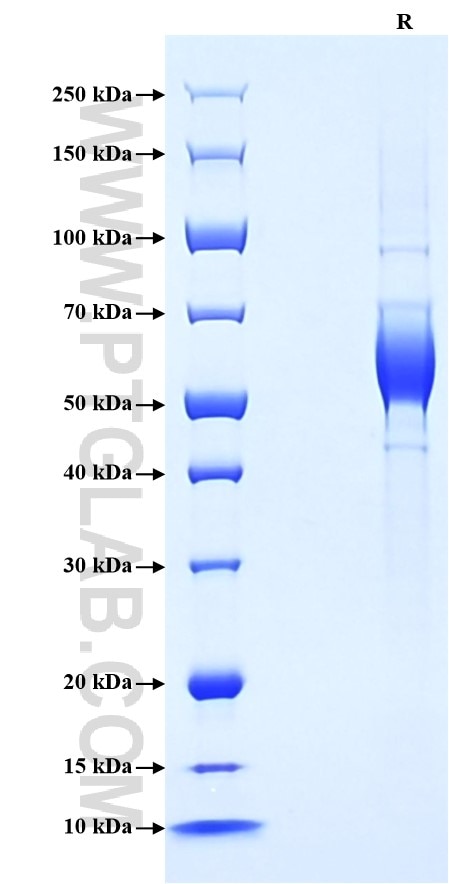Recombinant Human CLEC9A protein (rFc Tag)
Species
Human
Purity
>90 %, SDS-PAGE
Tag
rFc Tag
Activity
not tested
Cat no : Eg1444
Validation Data Gallery
Product Information
| Purity | >90 %, SDS-PAGE |
| Endotoxin | <0.1 EU/μg protein, LAL method |
| Activity |
Not tested |
| Expression | HEK293-derived Human CLEC9A protein Lys57-Val241 (Accession# Q6UXN8) with a rabbit IgG Fc tag at the N-terminus. |
| GeneID | 283420 |
| Accession | Q6UXN8 |
| PredictedSize | 48.4 kDa |
| SDS-PAGE | 52-65 kDa, reducing (R) conditions |
| Formulation | Lyophilized from 0.22 μm filtered solution in PBS, pH 7.4. Normally 5% trehalose and 5% mannitol are added as protectants before lyophilization. |
| Reconstitution | Briefly centrifuge the tube before opening. Reconstitute at 0.1-0.5 mg/mL in sterile water. |
| Storage Conditions |
It is recommended that the protein be aliquoted for optimal storage. Avoid repeated freeze-thaw cycles.
|
| Shipping | The product is shipped at ambient temperature. Upon receipt, store it immediately at the recommended temperature. |
Background
CLEC9A (C-type lectin domain family 9 member A), also known as DNGR1, CD370, is a type II membrane protein that contains C-type lectin domain. The C-type lectin domain family members share a common protein fold and have diverse functions, such as cell adhesion, cell-cell signaling, glycoprotein turnover, and roles in inflammation and immune response. Mouse Clec9A is primarily restricted to dendritic cells (DCs) and selectively expressed in mouse CD8+ conventional DCs (cDCs) and plasmacytoid DCs (pDCs), whereas human CLEC9A is also expressed on human DC subtypes. CLEC9A functions as an activating receptor that recruits Syk kinase and can induce the production of proinflammatory cytokines.
References:
1. Dambuza IM, et al. (2015). Curr Opin Immunol. 32:21-7. 2. McGreal EP, et al. (2004). Mol Immunol. 41(11):1109-21. 3. Caminschi I, et al. ( 2008). Blood. 112(8):3264-73. 4. Huysamen C, et al. (2008). J Biol Chem. 283(24):16693-701.
